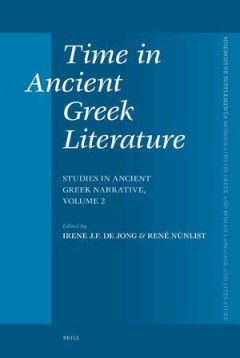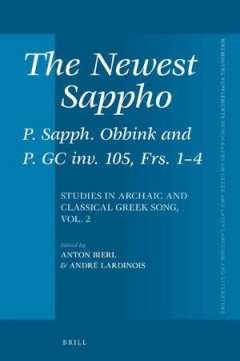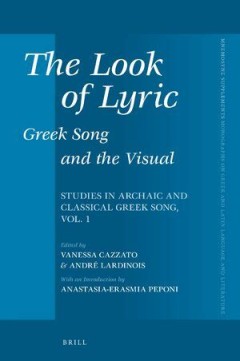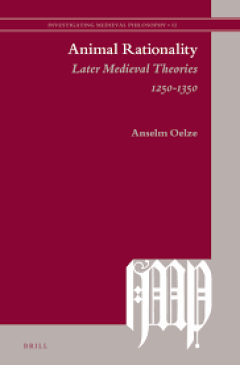Filter by

Women and War in Roman Epic
In Women and War in Roman Epic, Elina Pyy discusses the narrative and ideological functions of gender in the works of Virgil, Lucan, Statius, Silius Italicus and Valerius Flaccus. By examining the themes of violence, death, guilt, grief, and anger in their epics, she offers an account of the intertextual tradition of the genre and its socio-political background. Through a combination of classic…
- Edition
- -
- ISBN/ISSN
- 9789004443457
- Collation
- 342 hlm; ill., lamp.,
- Series Title
- The Language of Classical Literature, Volume: 33
- Call Number
- -

Time in Ancient Greek Literature = Studies in Ancient Greek Narrative, Volume 2
This is the second volume in a series of volumes which together will provide an entirely new history of ancient Greek (narrative) literature. Its organization is formal rather than biographical. It traces the history of central narrative devices, such as the narrator and his narratees,time, focalization, characterization, and space. It offers not only analyses of the handling of such a device b…
- Edition
- -
- ISBN/ISSN
- '9789047422938
- Collation
- 556 hlm; ill., lamp.,
- Series Title
- Mnemosyne, Supplements, Volume: 291
- Call Number
- -

The Skandapurāṇa Volume IIb = Adhyāyas 31-52. The Vāhana and Naraka Cycles
Skandapurāṇa IIb presents a critical edition of Adhyāyas 31-52 from the Skandapurāṇa, with an introduction and English synopsis. The text edited in this volume includes central myths of early Śaivism, such as the destruction of Dakṣa's sacrifice and Śiva acquiring the bull for his vehicle. Also included is an extensive description of the thirteen hells (Naraka).
- Edition
- -
- ISBN/ISSN
- 9789004277137
- Collation
- 384 hlm; ill., lamp.,
- Series Title
- -
- Call Number
- -

The School of Salamanca: A Case of Global Knowledge Production
Over the past few decades, a growing number of studies have highlighted the importance of the ‘School of Salamanca’ for the emergence of colonial normative regimes and the formation of a language of normativity on a global scale. According to this influential account, American and Asian actors usually appear as passive recipients of normative knowledge produced in Europe. This book proposes…
- Edition
- -
- ISBN/ISSN
- 9789004516441
- Collation
- 296 hlm; ill., lamp.,
- Series Title
- Thomas Duve, José Luis Egío, and Christiane Birr
- Call Number
- -

The Newest Sappho: P. Sapph. Obbink and P. GC inv. 105, Frs. 1-4 = Studies in…
Retraction Notice: Postscript (March, 2021): The Publisher notifies the readers that Chapter 2 of this volume (Dirk Obbink, “Ten Poems of Sappho: Provenance, Authenticity, and Text of the New Sappho Papyri”) has been retracted. For more information please view the statement by the editors in the Retraction Notice in the front matter of this volume and on page 9 of the Introduction. The reas…
- Edition
- -
- ISBN/ISSN
- 9789004314832
- Collation
- 560 hlm; ill., lamp.,
- Series Title
- Mnemosyne, Supplements, Volume: 392
- Call Number
- -

The Look of Lyric: Greek Song and the Visual = Studies in Archaic and Classic…
The Look of Lyric: Greek Song and the Visual addresses the various modes of interaction between ancient Greek lyric poetry and the visual arts as well as more general notions of visuality. It covers diverse poetic genres in a range of contexts radiating outwards from the original performance(s) to encompass their broader cultural settings, the later reception of the poems, and finally also thei…
- Edition
- -
- ISBN/ISSN
- 9789004314849
- Collation
- 404 hlm,: ill, lamp;
- Series Title
- Mnemosyne, Supplements
- Call Number
- -

The Land of the English Kin =The Land of the English Kin
This volume draws together a series of papers that present some of the most up-to-date thinking on the history, archaeology and toponymy of Wessex and Anglo-Saxon England more broadly. In honour of one of early medieval European scholarship’s most illustrious doyennes, no less than twenty-nine contributions demonstrate the indelible impression Barbara Yorke’s work has made on her peers and …
- Edition
- -
- ISBN/ISSN
- 9789004421899
- Collation
- 718 hlm; ill., lamp.,
- Series Title
- -
- Call Number
- -

Animal Rationality: Later Medieval Theories 1250-1350
In Animal Rationality: Later Medieval Theories 1250-1350, Anselm Oelze offers the first comprehensive and systematic exploration of theories of animal rationality in the later Middle Ages. Traditionally, it was held that medieval thinkers ascribed rationality to humans while denying it to nonhuman animals. As Oelze shows, this narrative fails to capture the depth and diversity of the medieval d…
- Edition
- Volume: 12
- ISBN/ISSN
- 978-90-04-36377-9
- Collation
- -
- Series Title
- -
- Call Number
- -

An Invisible Thread: Heresy, Mass Conversions, and the Inquisition in the Kin…
Author: Stefania Pastore In Toledo in 1529, a converso named Pedro de Cazalla declared that the connection between man and God was but a thread and that it should not be mediated by the Church. Hardly an isolated phenomenon, Cazalla’s inner spirituality was a widespread response to the increasing repression of religious dissent enacted by the Inquisition. Forced baptisms of Jews and Muslims…
- Edition
- Volume: 85
- ISBN/ISSN
- 978-90-04-71423-6
- Collation
- -
- Series Title
- -
- Call Number
- -

Aging Gracefully in the Renaissance: Stories of Later Life from Petrarch to M…
In Aging Gracefully in the Renaissance: Stories of Later Life from Petrarch to Montaigne Cynthia Skenazi explores a shift in attitudes towards aging and provides a historical perspective on a crucial problem of our time. From the late fourteenth to the end of the sixteenth centuries, the elderly subject became a point of new social, medical, political, and literary attention on both sides of t…
- Edition
- Volume: 11
- ISBN/ISSN
- 9789004255722
- Collation
- -
- Series Title
- -
- Call Number
- -
 Computer Science, Information & General Works
Computer Science, Information & General Works  Philosophy & Psychology
Philosophy & Psychology  Religion
Religion  Social Sciences
Social Sciences  Language
Language  Pure Science
Pure Science  Applied Sciences
Applied Sciences  Art & Recreation
Art & Recreation  Literature
Literature  History & Geography
History & Geography